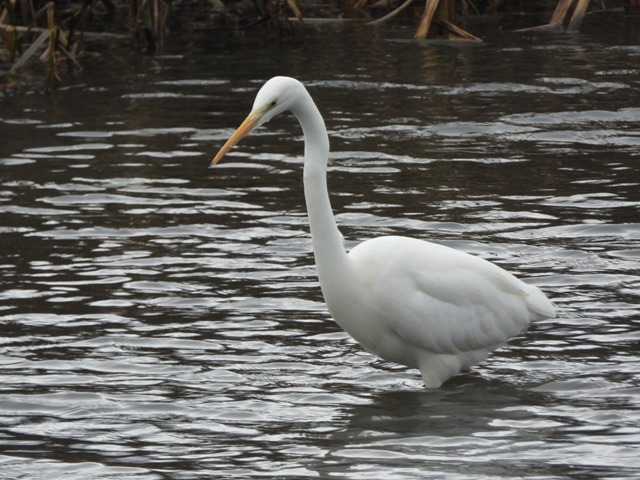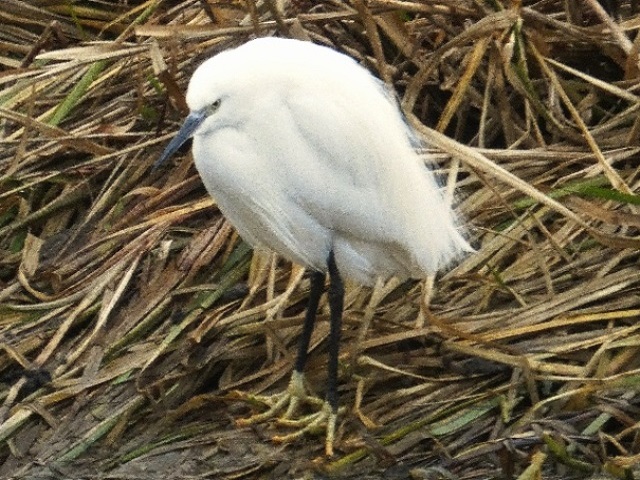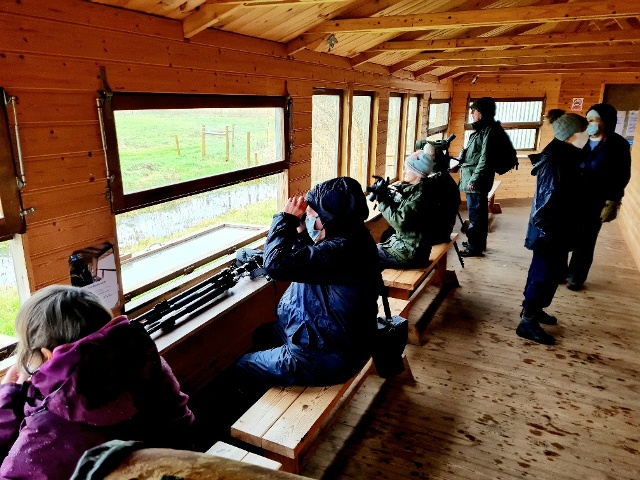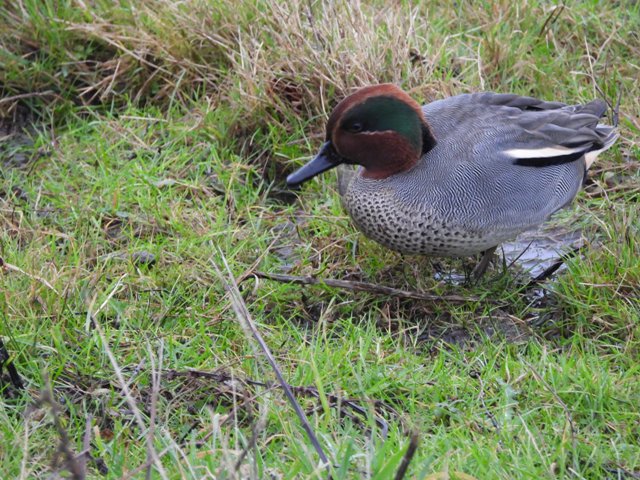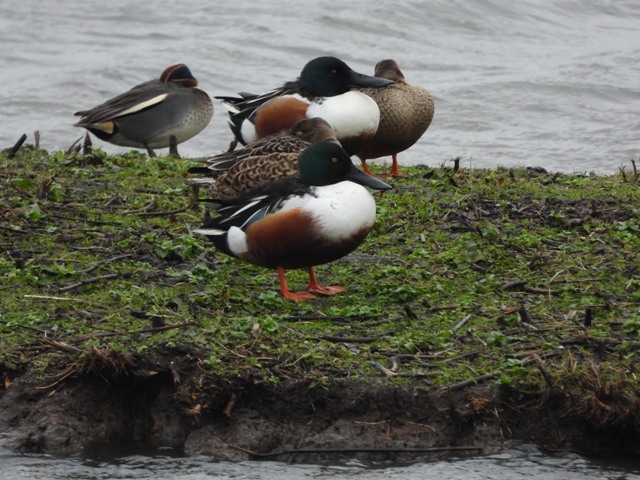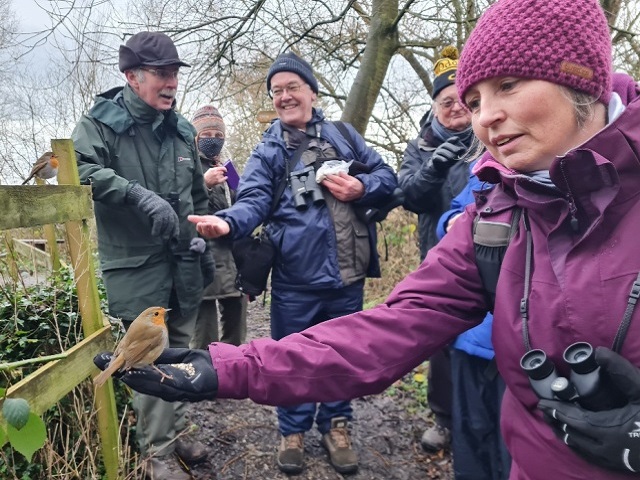Field Meeting Reports – 2022
“The Harp” & Denhall Quay – Saturday 10th December 2022
“Mad dogs and Englishmen …” But it was actually 8 mad birders that braved the elements at “The Harp” for our December meeting! Despite the snow, sleet and ice that greeted us at the rendezvous, we thought we might as well still have a walk – even if we might not see many birds!
Actually, there were Blackbirds, Robins, Wood Pigeons and House Sparrows in the trees and bushes surrounding the car park, as we donned our (many) layers of clothing. The occasional Starling flew over and Carrion Crows and Little Egrets could just be picked out through the gloom on the marsh.
Following the path along the edge of the marsh, we could hear the evocative “wink-wink” call of Pink-footed Geese far away and eventually a small cloud of birds rose from the marsh and drifted away. A flock of maybe 150 Wigeon could be identified by the white wing patches of the males just penetrating through the mist.
We made it to Net’s Cafe at Denhall and decided to dry out and warm up over a hot drink. A friendly Song Thrush appeared to be looking for any dropped crumbs!
We noticed that the sky was brightening so we resumed our walk towards Denhall Lane. A small group of Greenfinches were a welcome sight in the improved light. We also spied a mixed flock of Redwings and Fieldfares feeding on hawthorn berries and on the ground. Always wary, we never got great views of them, but they were still nice to see. The photos attached were not from this trip, as you can probably tell from the bright conditions! They were taken at Ness Gardens a few years ago.
At this point, the sky was looking threatening again to the west, so we returned to the cars.
We may not have seen many of our target birds, but everyone enjoyed the fresh air and jovial company.
Thank you to John Carus for the two “group” photos – OK, it was a small group this time! Hopefully the weather will be better next time.
Hugh Stewart
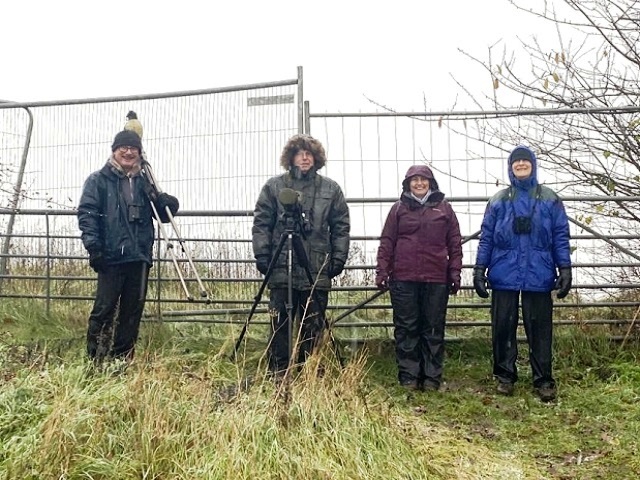
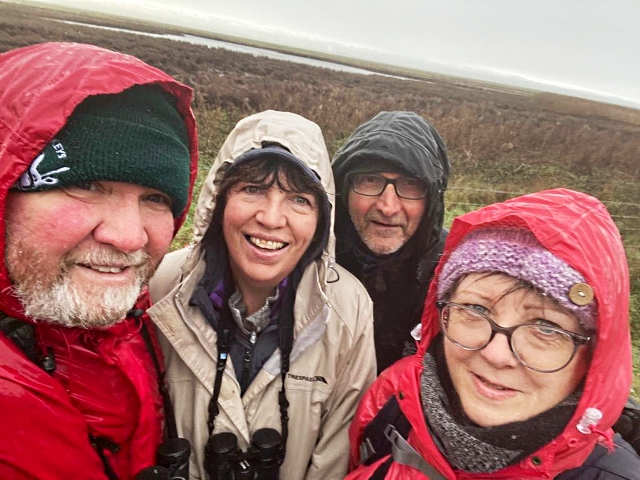
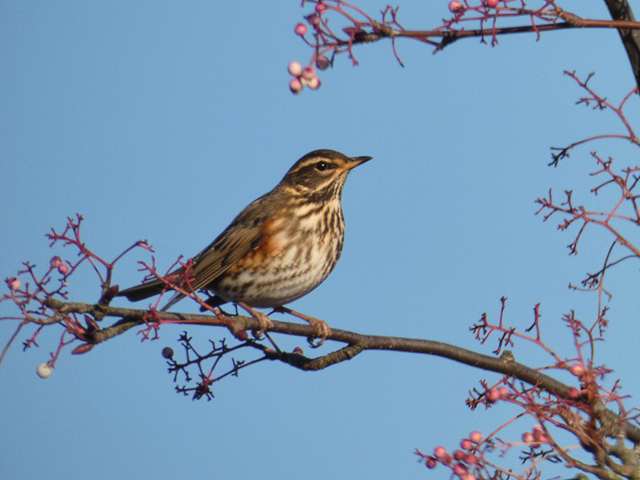
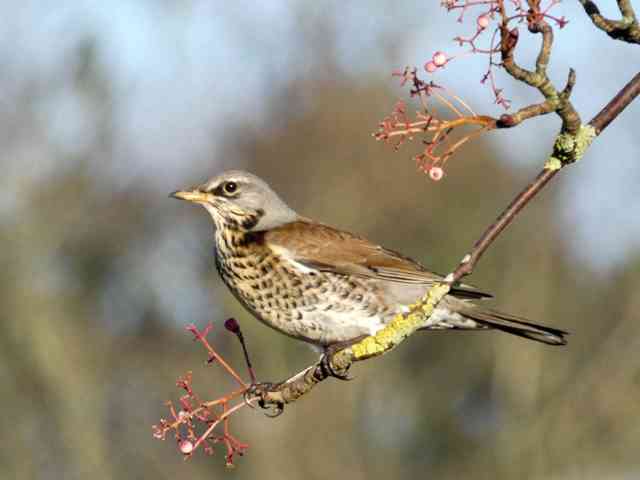
Hale Lighthouse – Sunday 27th November 2022
There was a wonderful turn-out for our Hale trip, 21 people in total. It is gratifying that Members are supporting the programme so well. We had the obligatory group photo by the Childe of Hale statue.
The walk down the road towards the lighthouse yielded the expected Blackbird, Robin, Starling and Collared Dove, and a small flock of House Sparrows.
The first grass field held at least 30 Curlew and a gaggle of Canada Geese. Unfortunately, there were people on the shore so we saw only Mallard and Teal here. But walking a little way up-river we found some hoped-for waders – mostly Redshank plus a couple each of Turnstone and Oystercatcher. A party of 3 Stonechats brightened up a grey day. Surprisingly, there were several Cornflowers in bloom – or maybe not so strange given the mild autumn.
We started retracing our steps back to the village for lunch. En-route, we saw a family of Pied Wagtails, which included 2 juveniles with a yellowish wash to their faces.
In the afternoon we walked to Hale Duck Decoy. We scanned Carr Lane Pools, but they were very quiet. We did see a male Sparrowhawk being chased away by 2 Crows though.
Our tour of the Decoy was a great success, a first visit for most members. We were guided around and given an informative commentary by the 3 volunteers from the Friends of Pickering Pastures, on the history and functioning of the Decoy. Simply, it was an old system for catching duck for the pot, before guns were invented. We’ve included a photo of one of the “pipes” used to funnel the duck.
Bird highlights here were a Green Sandpiper, Little Grebes and for a lucky few a brief glimpse of a Barn Owl. We also saw some of the continental sub-species of Cormorant (P. carbo sinensis) that now breed here, flying in to roost for the night. A big thank you to our hosts for a wonderful and unique experience.
We sadly made our way back to the cars, ending another successful trip.
The photos are from Ellie and Bill, thank you.
P.S. Following the visit, we were informed that our donation to the Decoy would go towards the repair of the boardwalks.
Hugh Stewart
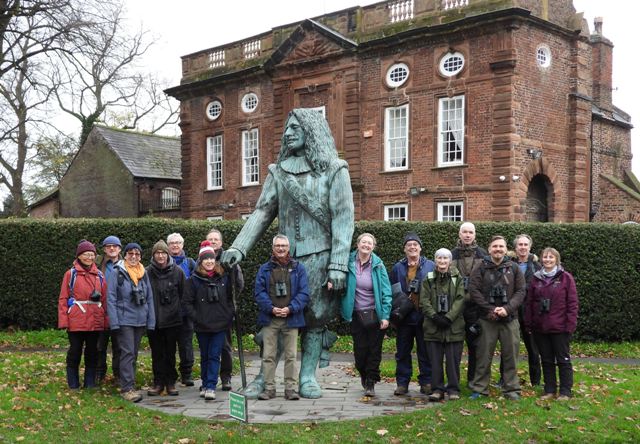
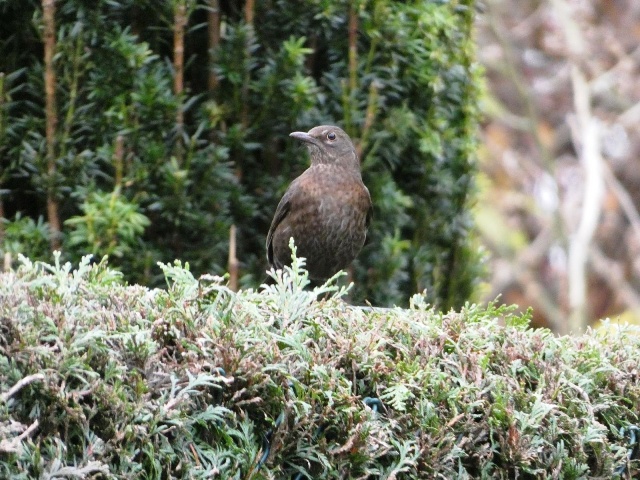
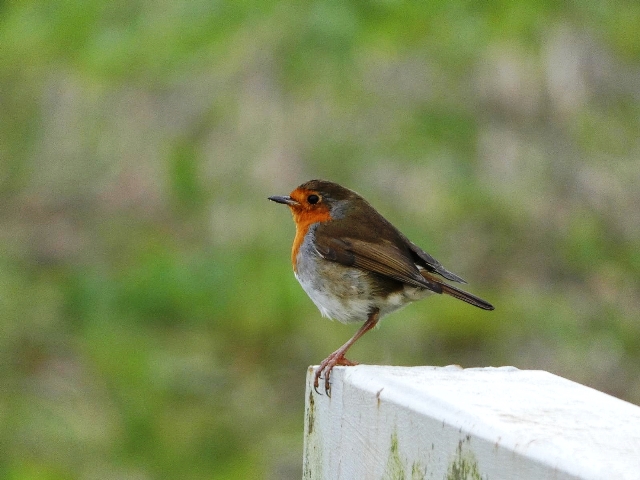
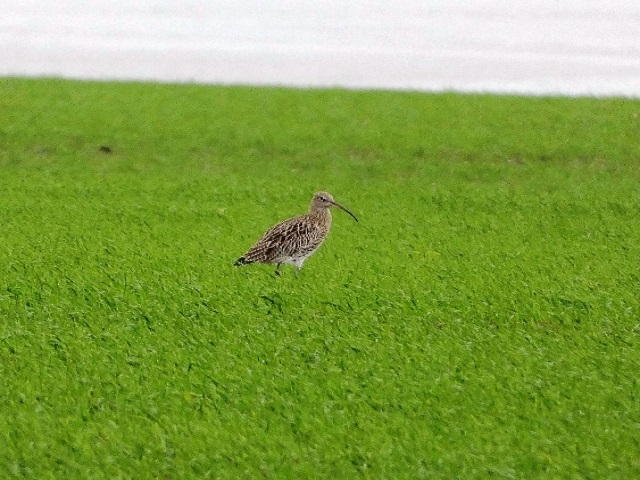
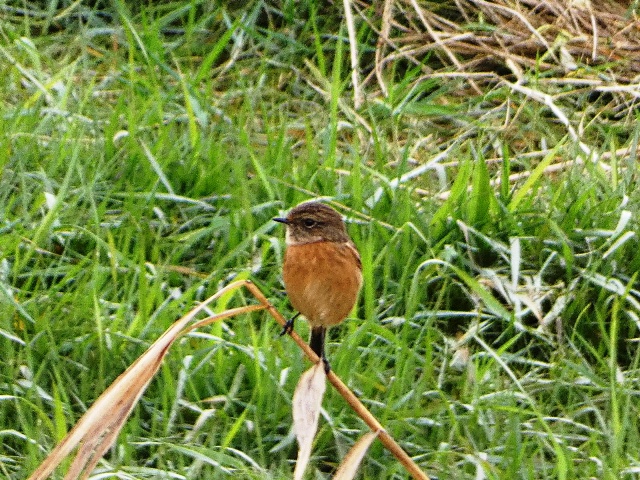
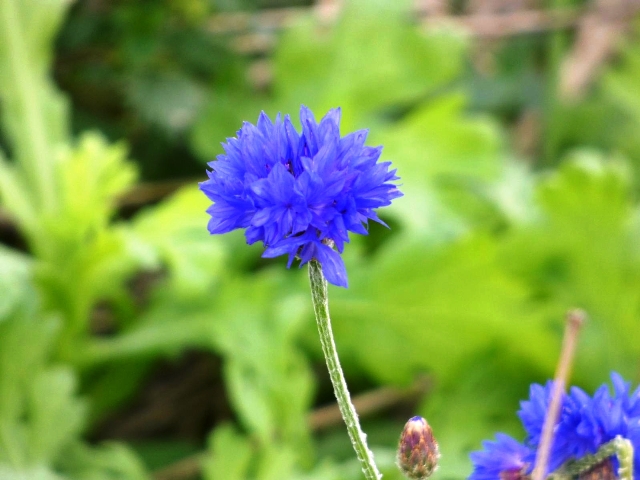
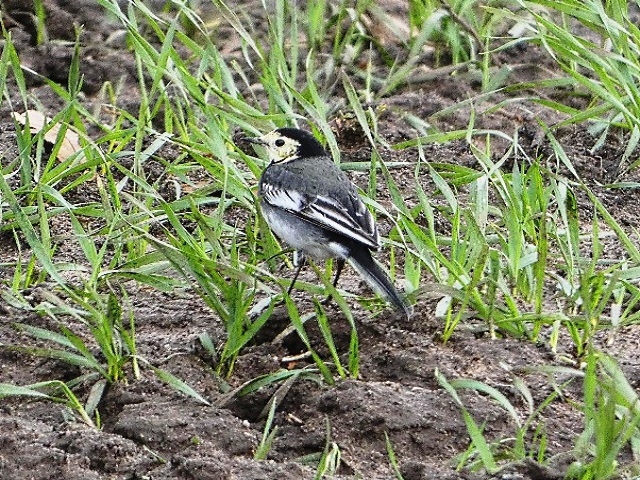
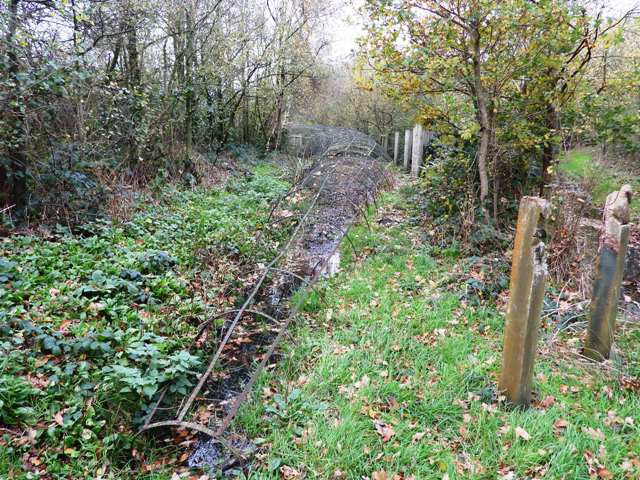
Marbury Country Park – Saturday 8th October 2022
It has been a while since we visited Marbury Country Park, but I think everyone enjoyed the day, with a good variety of birds seen. The weather was a great improvement on Leasowe too!
Greenfinch were nice to see, with a mix of bright males, females, and streaked juveniles. The mere held lots of water birds as expected. From the reedbed hide overlooking Budworth Mere, there were huge numbers of Great-crested Grebes, a couple of Little Grebes and several Tufted Duck. At the back, Greylag and Coot were the main species, with Cormorant and Heron also.
The woodland hide had the best feeding station with 2 busy Nuthatches plus Blue, Great and Blue Tits. A Buzzard circled low overhead giving great views. We dragged ourselves away to have lunch.
After the break, we walked towards the other end of the reserve. Sadly, Hadyn’s Pool was overgrown and dry, but further on Neumann’s Flash was productive. There were numerous Lapwings, Teal and at least 2 Ruff and a single Curlew. 2 Snipe hugged the reeds.
Sighting of the day was a Water Rail strutting across the water in front of a lucky few. On the way back, a very brief Kingfisher was missed by nearly everyone!
In total the group saw/heard at least 46 species, plus butterflies and dragonflies out in the afternoon sunshine.
It was a longish day but well worth the effort.
Photos courtesy of Ellie, Maks and Hugh
Hugh Stewart
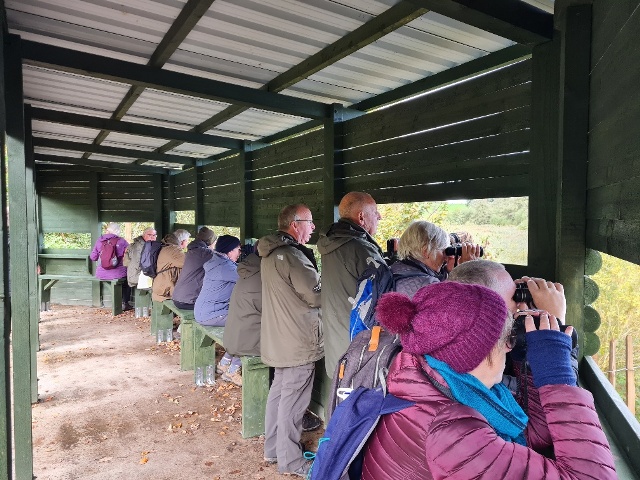
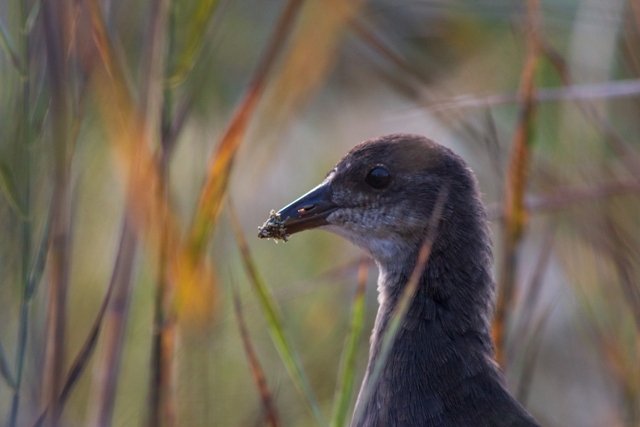
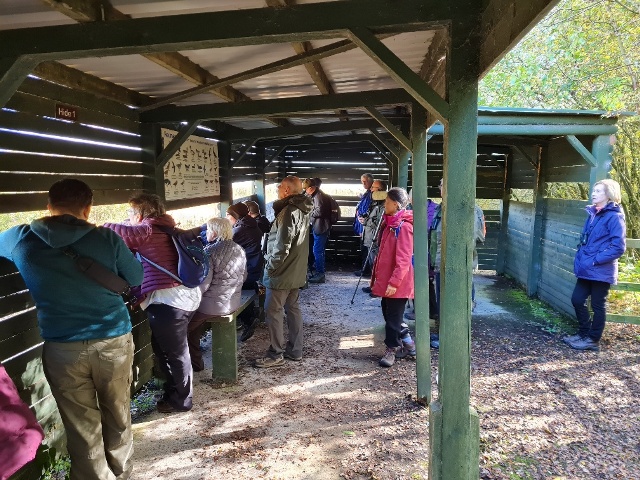
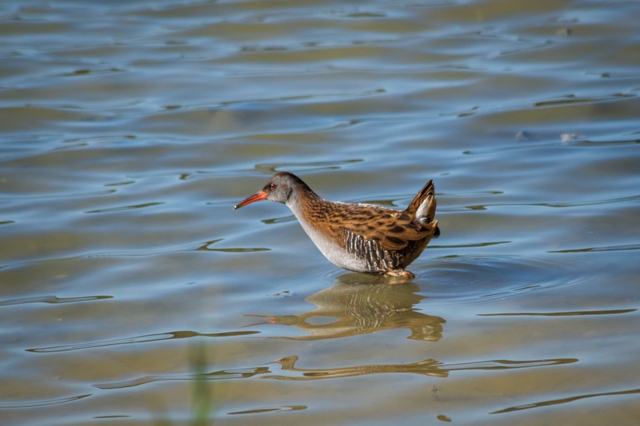
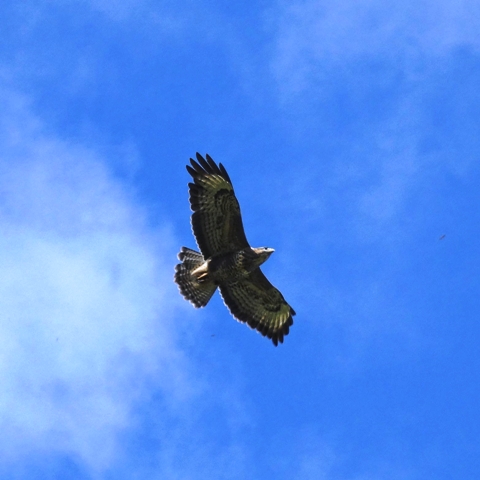
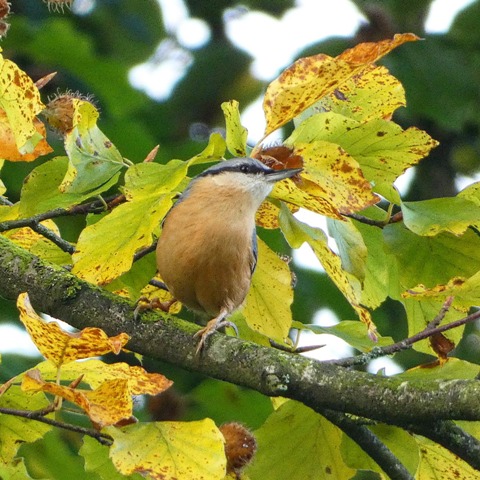
Leasowe – Tuesday 27th September 2022
Oh why couldn’t the summer have lasted another week?! But despite the wet and windy day, an awesome number of Members gathered by the Lighthouse. Thank you everyone for turning out.
We set off along Lingham Lane to gain some shelter from the wind. Within a short distance we enjoyed single Chiffchaff and Grey Wagtail, and a charming pair of Goldcrests. A Sparrowhawk sped over the fishing lake.
Moving on, behind the horse paddocks were good numbers of Little Egrets and Curlews, roosting over the coming high tide, with more Curlew flying in to join them. A few Swallows and one House Martin flew low over the same field.
A mix of waders were sitting on the groyne, mostly Redshanks, plus the odd Oystercatcher, Turnstone and Knot.
Many members departed at lunchtime – I don’t blame them! But an intrepid 4 of us walked up to scan Kerr Fields. We were rewarded with lovely views of a couple of Goldfinch feeding on seed heads, a party of 6 Mistle Thrushes and a female Kestrel hunting along a fence-line.
At the Green Hut Cafe, hoards of Starlings swooped on any dropped crumbs!
Our final bird was a female Wheatear on the Prom, feeding up before continuing on her migration south to central Africa.
The conditions made birding hard, but we still saw 39 species between us, including some quality birds. Hopefully the weather will be kinder for our next trip!
Photos courtesy of Ellie, Peter and Bill.
Hugh Stewart
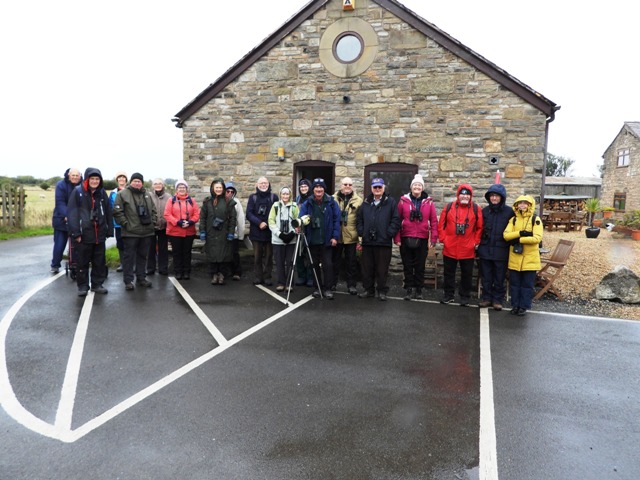
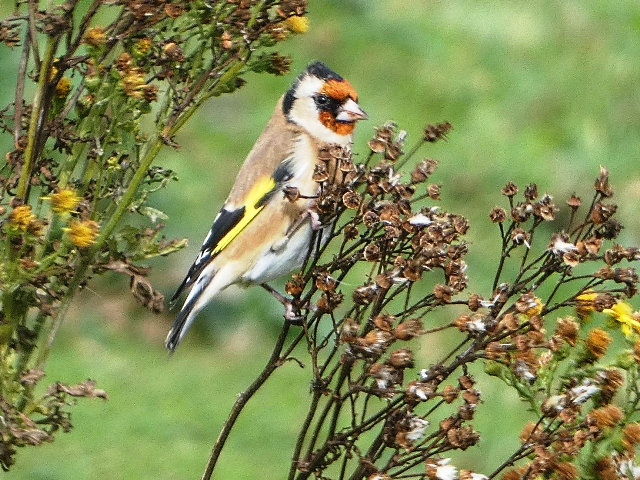
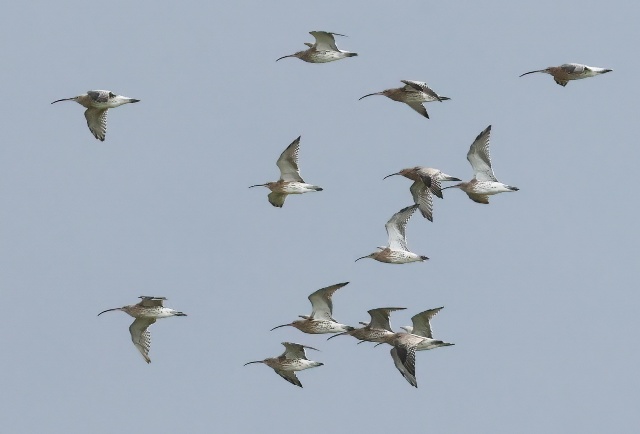
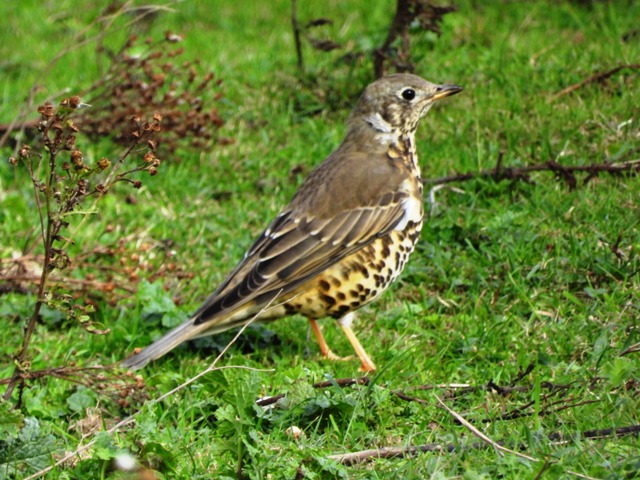
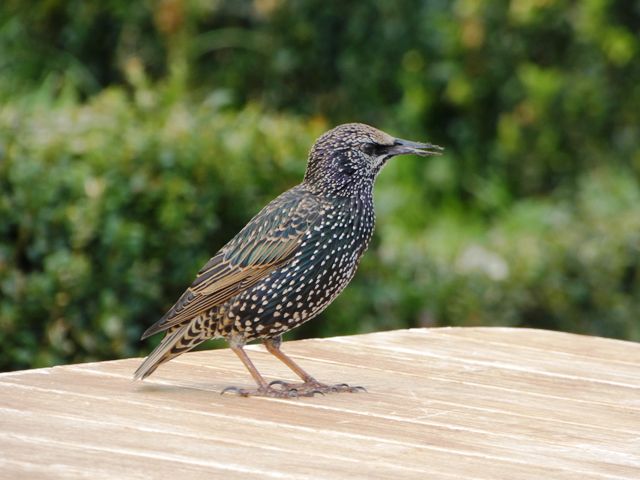
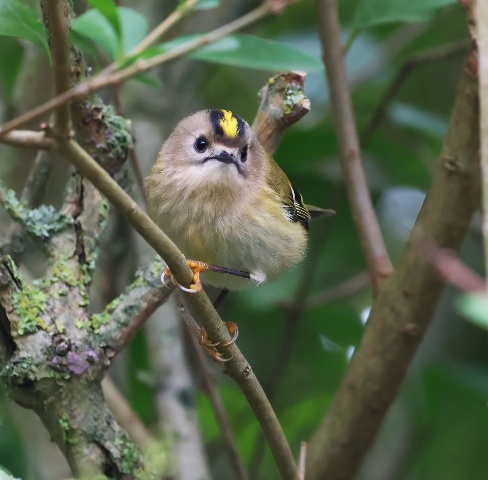
Cilcain – Saturday 16th July 2022
With high temperature warnings for the following couple of days, there was a slight concern that conditions would be uncomfortable. But as we started our walk, the weather was perfect with high broken cloud and a slight wind making it comfortable.
Overhead were a mix of active Swallows, House Martins and Swifts. We were accompanied by Buzzards for much of the day, their mewing calls often drawing our attention. At one spot on the tree-lined track a flock of Long-tailed, Blue and Great Tits played hide and seek amongst the leaves. There were glimpses of 2 or 3 Bullfinches. Then we had good views of a young male Redstart developing its grey back but still with streaky juvenile breast feathers. A gorgeous looking bird.
By an isolated house we came across a wild Welsh cat! Butterflies were much in evidence including Small Tortoiseshell (photographed), Ringlet and Meadow Brown and one of the blue Damselflies.
We emerged into more open moorland, with ferns and flowering heather. Here were a number of Stonechats in family groups – so many it was difficult to keep a tally. Linnets and lots of Meadow Pipits were seen too. We had been scanning for them and we finally saw a flock of 7 Ravens flying by and circling in a thermal. A “honk” helped confirm their identity.
We reached the high point of the walk before dropping down to the valley stream for lunch. We copied the sheep and found some shade under a tree. Tim even had time for a nap!
As we were eating, we heard the rattle of a Yellowhammer but couldn’t spot it. However when we continued our walk we saw 2 male Yellowhammers fly by and one landed in a nearby tree, giving great views. This was the highlight for us as this species is sadly in serious decline locally. On the top reservoir a Grey Wagtail gave fleeting views for some, and the lower water yielded a Grey Heron that alighted in a conifer. As we returned to the cars, the day was warming up as the clouds had dispersed but it was never unpleasantly hot.
There were only 6 of us out but the beautiful scenery and some special birds combined to make a cracking day! Identifying the many juvenile birds added to the fun!
Hugh Stewart
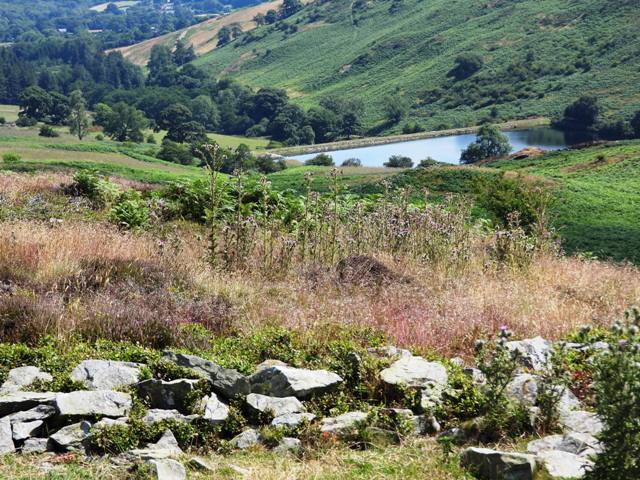
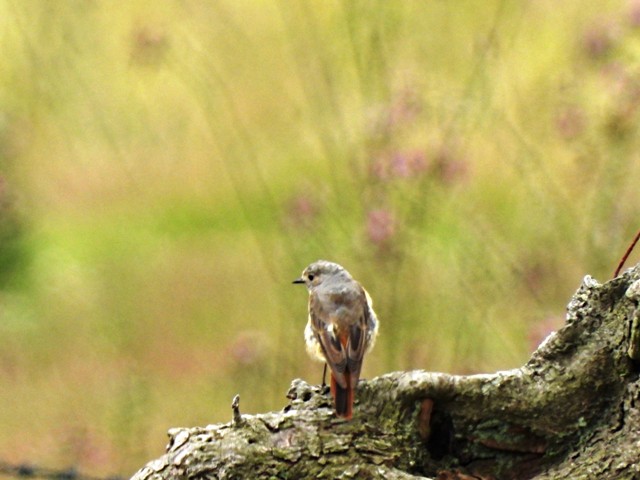
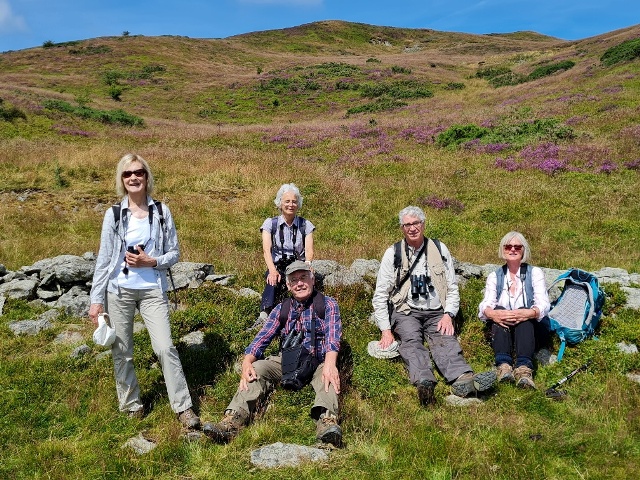
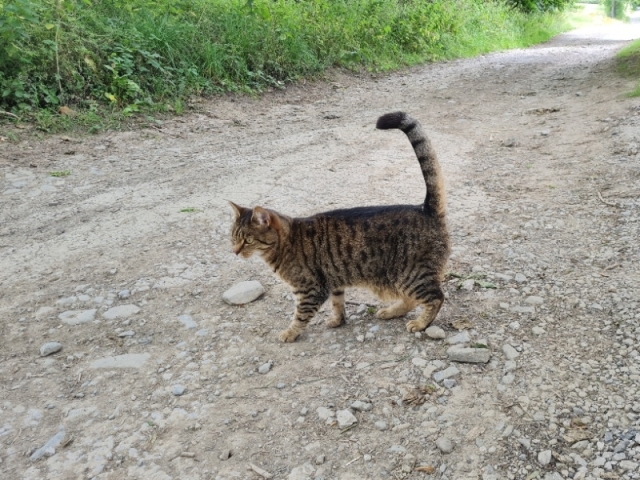
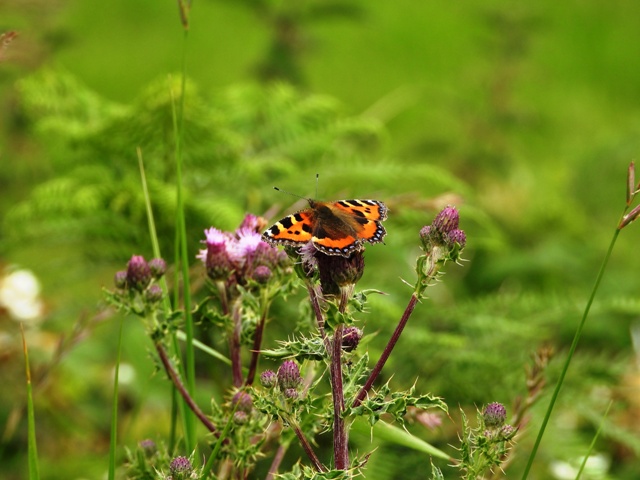
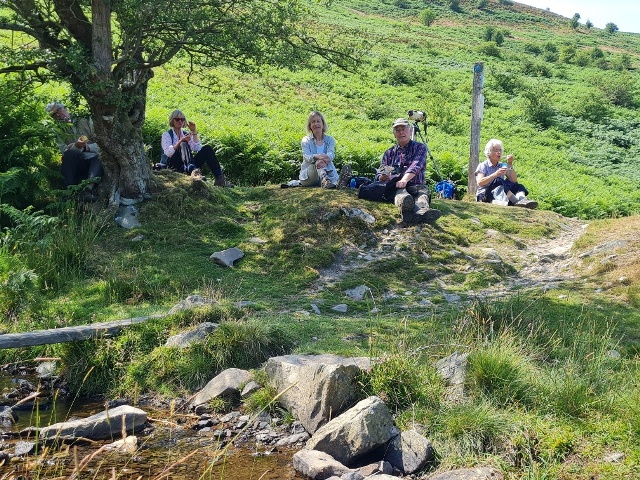
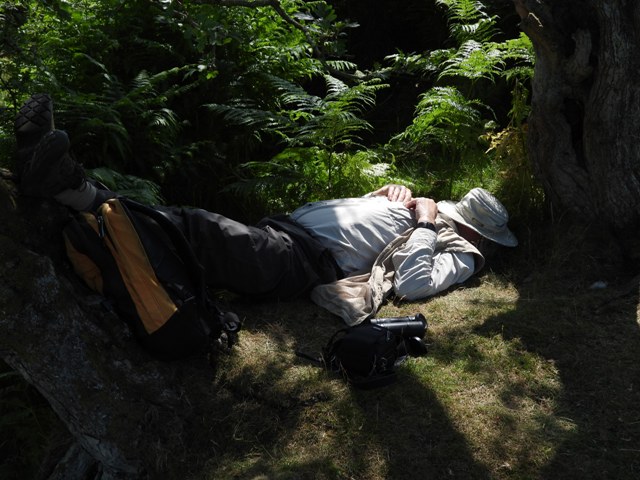
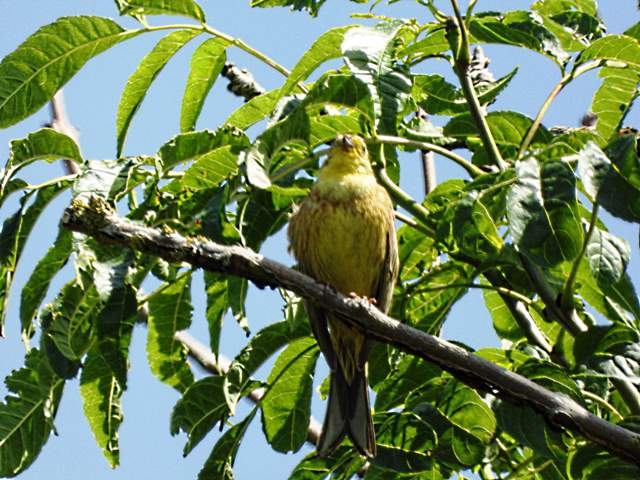
Carsington Water – Sunday 26th June 2022
What a wonderful day we enjoyed at Carsington Water on our latest coach trip! Those members who didn’t go missed a real treat. The weather was kind, the scenery was beautiful, we saw a nice variety of birds, and there was even a vintage car rally to add to the interest!
After a brief visit to the impressive Visitors Centre, we meandered to the Wildlife Centre hide. We stayed here quite a while as we ticked off Little Ringed Plover, Red-crested Pochard, Common Sandpiper. There were numerous Great-crested Grebes and a couple of Little Grebes. House and Sand Martins fed over the water. Canada Geese had cute goslings in tow. Unfortunately, the feeders were empty but a single Tree Sparrow sat on top expectantly.
Eventually we dragged ourselves away to continue following the path around the reservoir. At one point a mixed flock of Blue, Great and Long-tailed Tits were seen feeding intently amongst the trees. We stopped for lunch at Lane End hide before carrying on again. At Paul Stanley hide, we were surprised at the large number of male Tufted Duck all gathering together. We speculated whether it was a stag party!
At this point, we decided to turn back. Not long after, a female Ruddy Duck was found amongst a large flock of Canada Geese just off-shore from the Sheepwash car park. Blackcap, Chiffchaff and Willow Warbler were all heard but were difficult to spot in the lush foliage.
It was not just birds to admire – there were some impressive wild flower meadows, with Common Spotted Orchids and Yellow Rattle dotted around amongst other species.
We got back to the centre in time for refreshing drinks and ice-creams before returning to the coach.
We saw (or heard) 50 species as a group, a nice round number.
Hugh Stewart
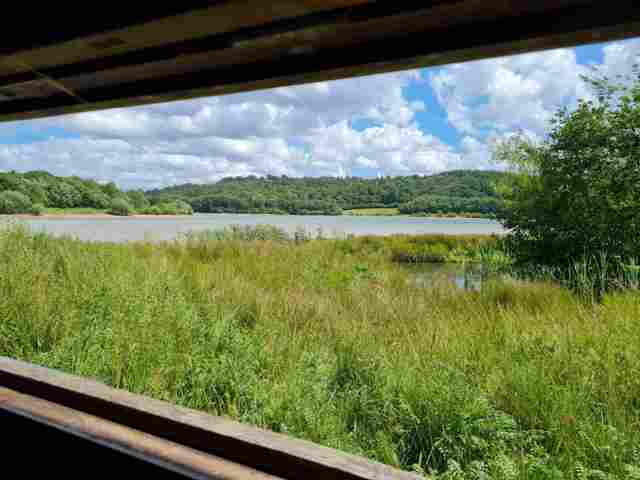
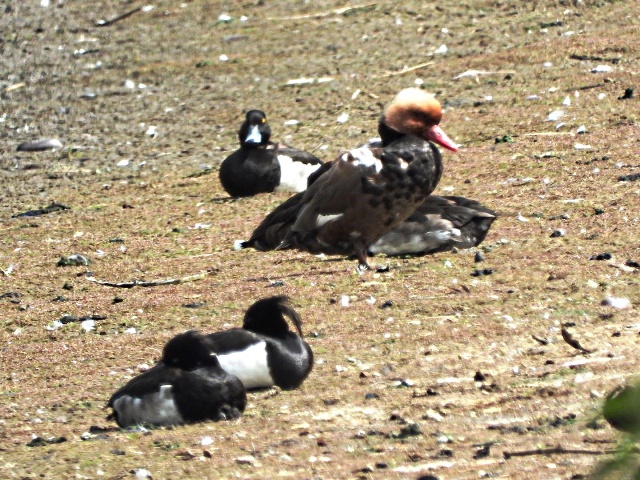
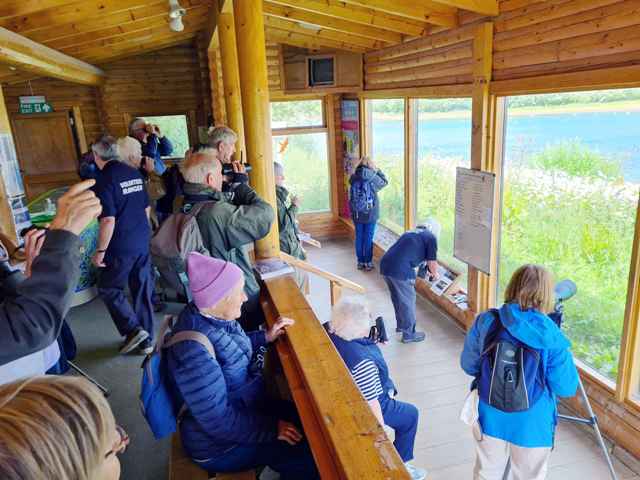
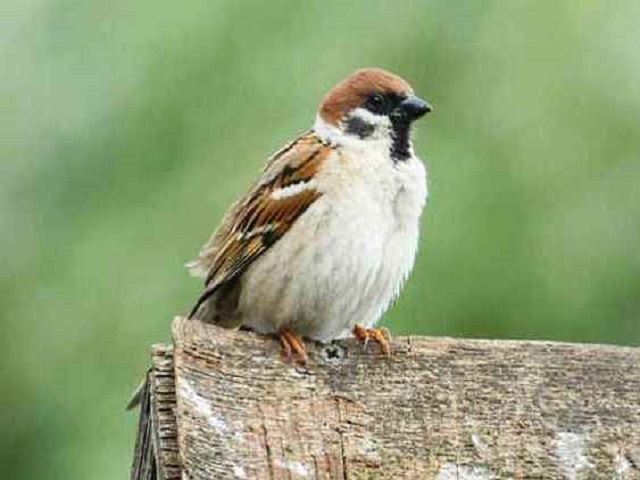
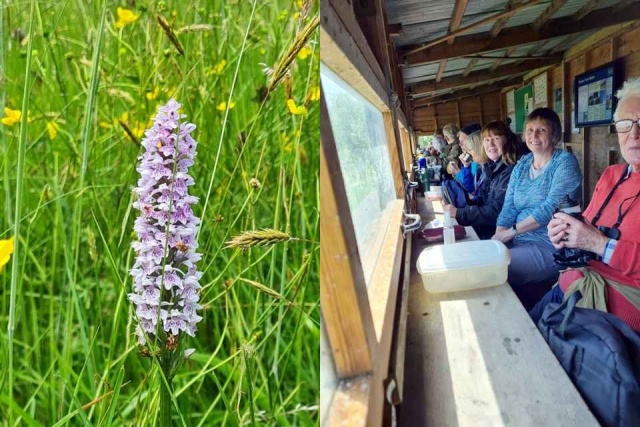
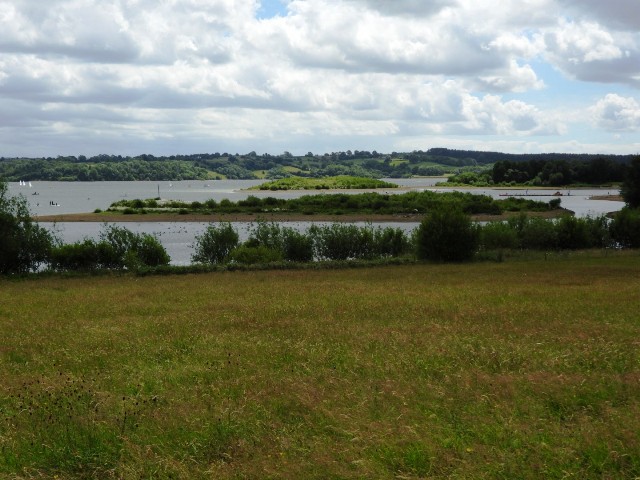
Abergwyngregyn – Thursday 9th June 2022
Not exactly Flaming June, but we had an enjoyable day, with only a few spots of rain briefly.
We strolled slowly up through the village, seeing House Martins still visiting nests on the old hotel, House Sparrows chirping in the gardens and Jackdaws overhead.
Continuing up the wooded valley, Paul did well to spot a well camouflaged Grey Wagtail on a grey and yellow (lichen) rock in the river! A little further on, a Dipper appeared and stopped briefly before flying up-stream. Most of the group managed a glimpse – sorry Joyce!
As we proceeded, the woods opened up partially. Scanning a stone wall, a female Redstart was dropping to feed in the ferns before returning to the wall. It was somewhat distant, but we were to enjoy closer views of both female and a smart male bird later. A Garden Warbler was heard but refused to show itself.
Chiffchaff, Willow Warbler and Blackcap completed the warbler species seen or heard. Close to the Falls, a family of Wheatears were feeding and being fed. At our lunch stop we were entertained by both Redstart and Siskin.
The return back did not add too many more species, but was pleasant nevertheless.
Back at our cars, we started to disperse for the journey home.
Another successful trip was completed, with all the main target species seen.
Hugh Stewart
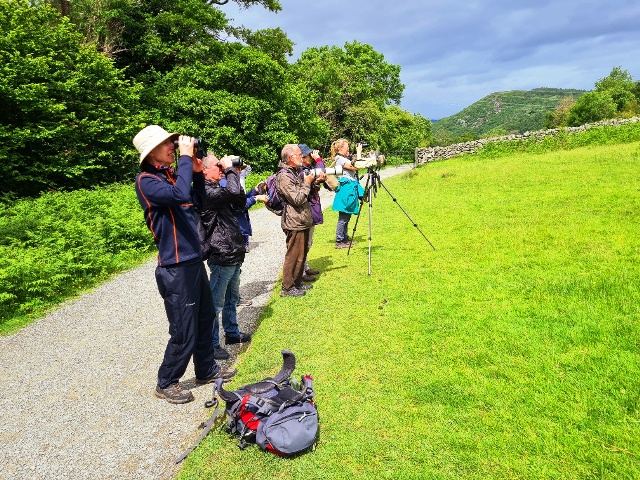
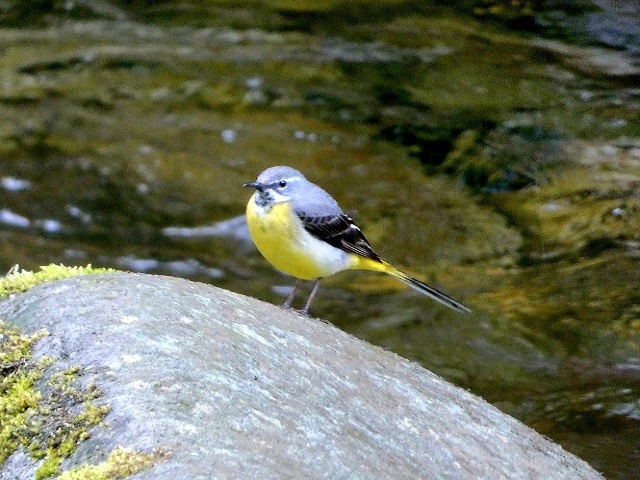
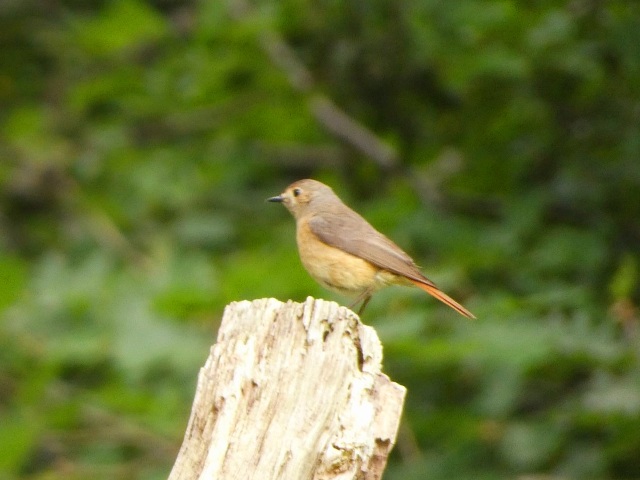
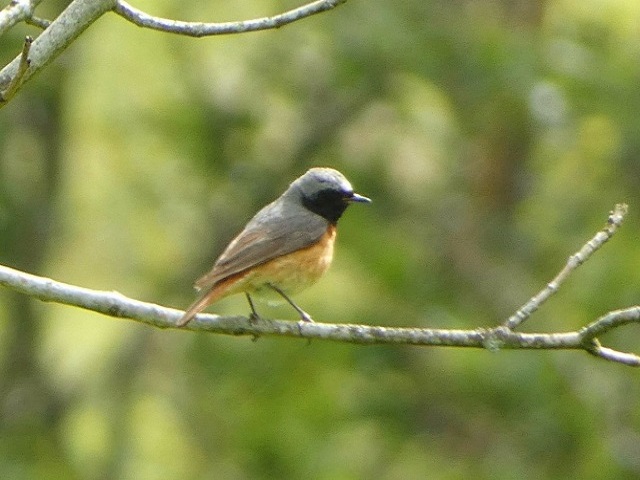
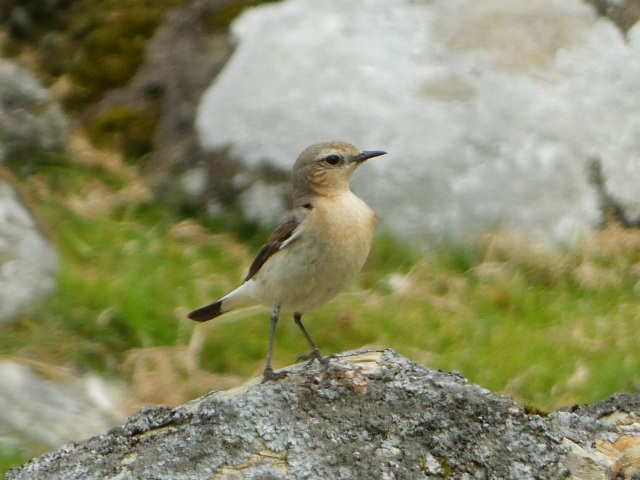
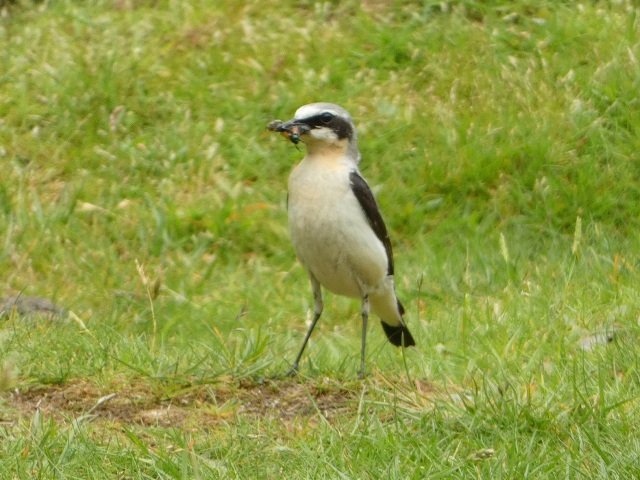
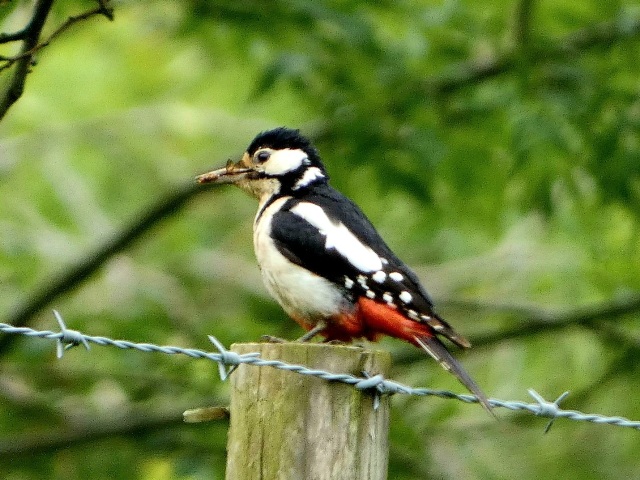
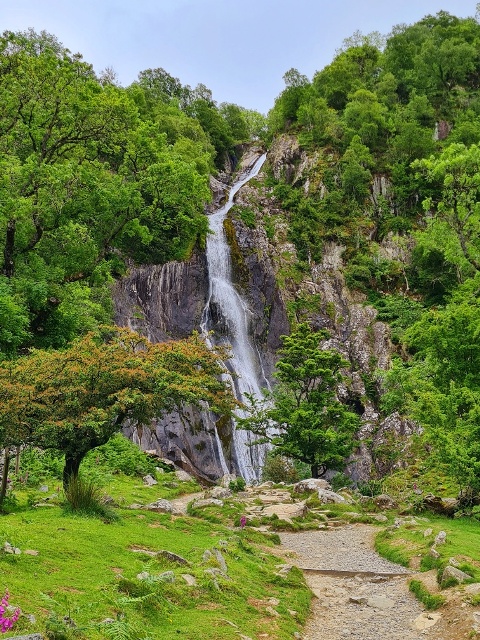
Bolton Abbey – Saturday 7th May 2022
What a wonderful return to our coach trips after a 2-year enforced break. Bolton Abbey and the River Wharfe provided a spectacular setting, and the birds did not disappoint.
From the Abbey car park, we walked down to the river and started to follow it upstream.
It was pleasing to see so many Common Sandpipers on the rocks lining the river. Curlews occasionally flew over giving their bubbling call. We also enjoyed incredibly close views of both male and female Goosanders on the water. Not everyone’s cup of tea, but Mandarin Duck were also common, the males looking especially gaudy decked out in their colourful breeding plumage.
In the woods, a pair of Pied Flycatchers were showing great interest in a hole in a large dead tree, enabling excellent views of both birds. Chiffchaff, Willow Warbler and Blackcaps were seen, all singing in earnest.
Our lunch break beside the river was accompanied by Mallard and Black-headed Gull interested in any dropped titbits! Red Kite was seen crossing the valley, a sign of their continuing expansion from the reintroduction schemes. On a quiet stretch of the river, Sand Martins were busy swooping about and investigating nest holes on the sandy bank. Dipper and Kingfisher were seen by a lucky few only in this area too! Pied Wagtails were frequent, but Grey and Yellow Wagtails were also seen.
As we returned to the coach, ice creams seemed to be a popular reward for our efforts! 51 species were seen by the group in total, a good number and including stunning views of some of the birds.
A big thank you to the Members who supported this trip after the break. We are sure that the next coach meeting will be equally successful.
Hugh Stewart
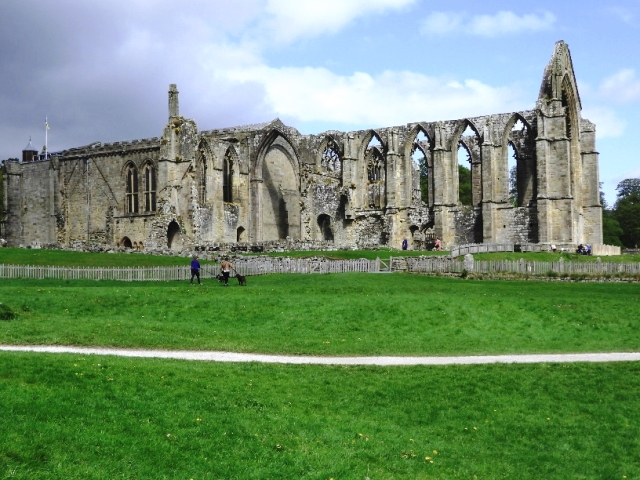
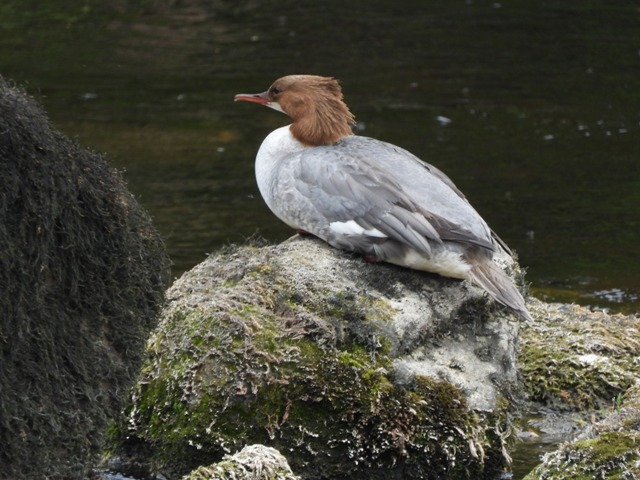
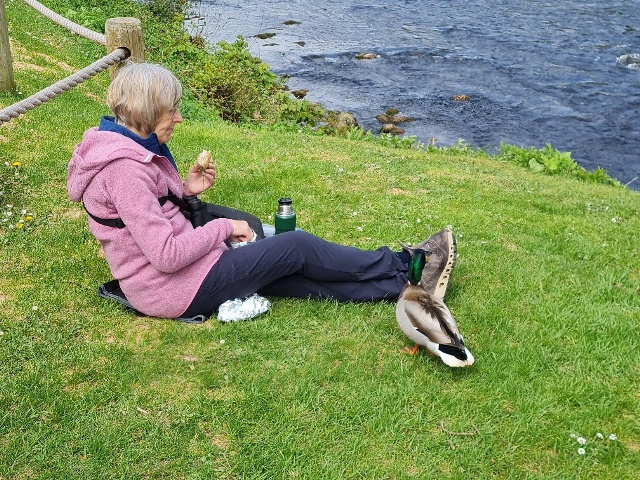
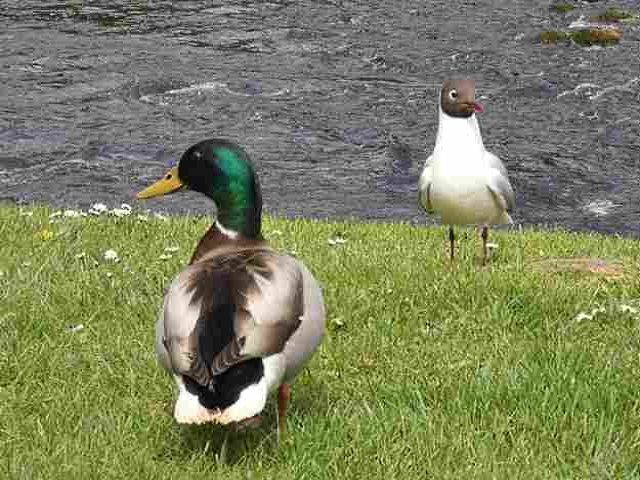
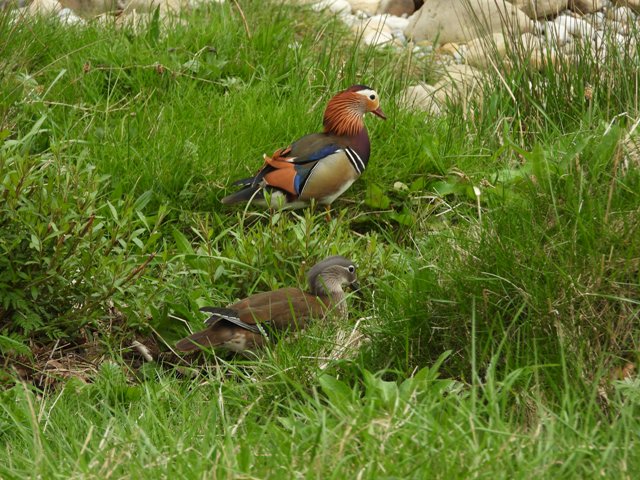
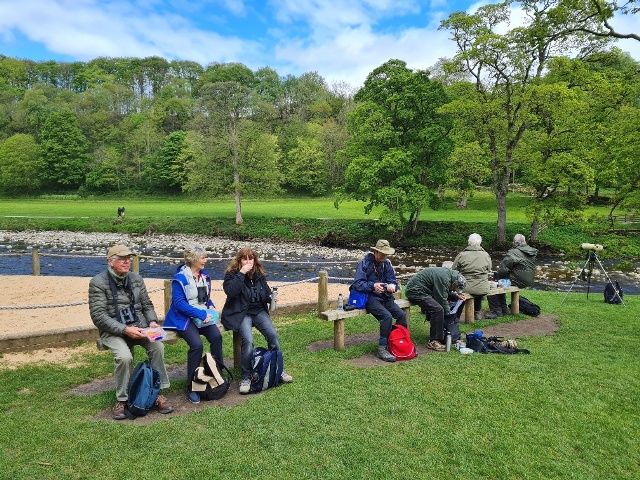
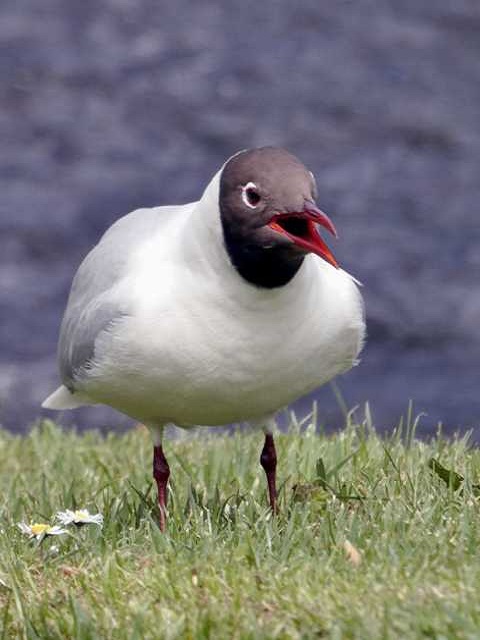
Chester Greenway – Wednesday 14th April 2022
Joyce and I were the first to arrive at the rendezvous, and were rewarded with a glimpse of a Sparrowhawk speeding over the car park and into a garden!
There was a slight drizzle falling as we all departed on our walk, but luckily this cleared up with occasional glimpses of the sun. Wood Pigeons and Blackbirds were plentiful in the park. Onto the Greenway proper, we quickly began to hear Chiffchaff, and there seemed to be singing birds regularly along the whole walk! They were generally showy although mostly high in the trees, but Ellie did manage this image below.
Blackcap were fewer and more skulking, but most of us saw at least one eventually. After hearing a couple of snippets of the lovely descending song of Willow Warbler, one finally showed but it was impossible to get a good photo. Much discussion on the separation of these two similar species when they’re not singing then ensued!
Robins were vocal and always posing, one with a beak-full of food for its chicks. A pair of Great Tits were busy collecting material to line their nest. A Dunnock also sang nicely for us, an often under-rated bird. Wrens were also vocal with one bird scurrying mouse-like along the ground.
We lunched at the welcoming Meadow Lee Farm Café (Ellie enjoyed the Carrot Cake!), where a Pied Wagtail sat on a farm shed.
We didn’t add many species on the return walk, but Buzzard and finally Mistle Thrush were added. The only woodpecker we saw was a wooden sculpture, one of a few creative artworks on the route.
Joyce and I were also the last the leave. Again, we were luckily rewarded with a Buzzard flying really low over our heads being chased by a Herring Gull and two Carrion Crows!
Although we only saw a modest 28 species in total for the day, it was a pleasant walk, although we had to watch out for the cyclists, so I wouldn’t recommend visiting at the weekend.
Thank you to Ellie for her lovely photos.
Hugh Stewart
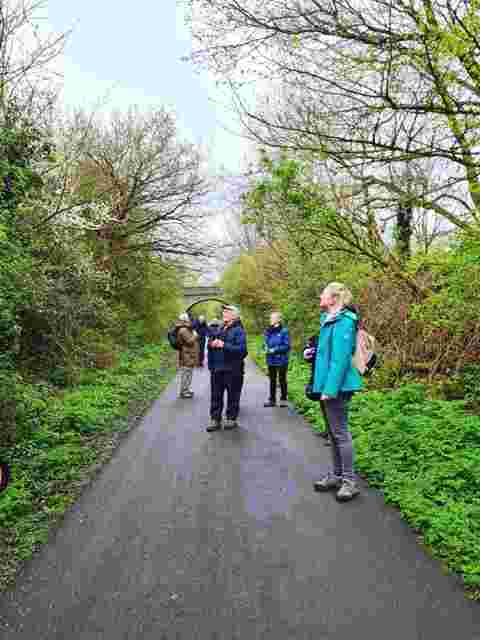
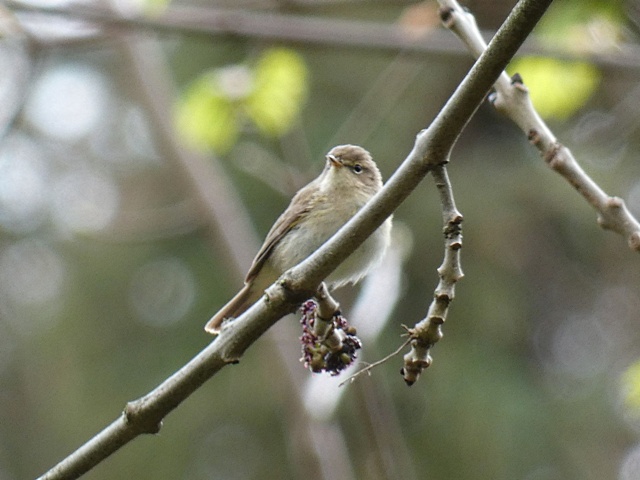
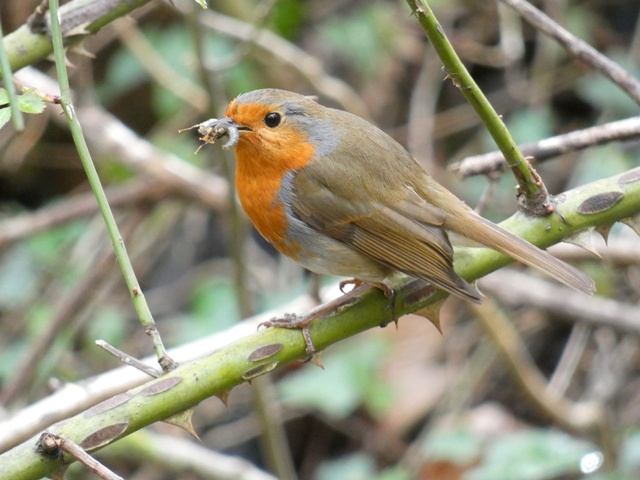
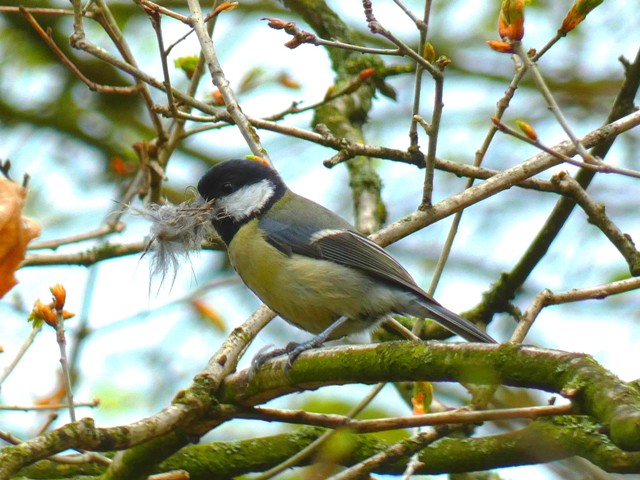
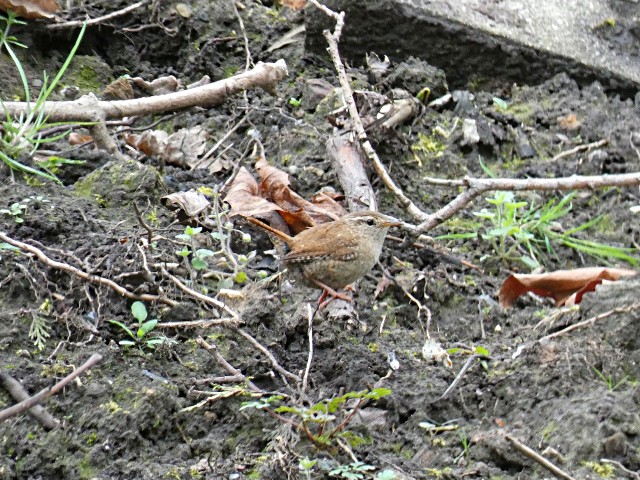
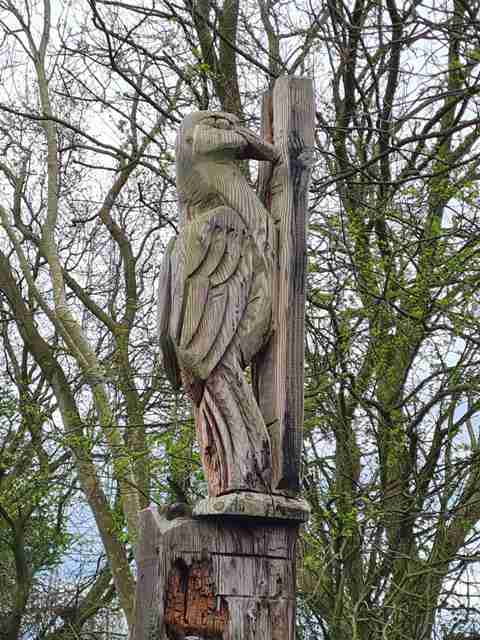
Greenfield Valley Heritage Park – Saturday 12th March 2022
There was another great turn-out for our visit to Greenfield Valley Heritage Park and there was a pleasant spring feel to the weather as we set off up the valley, following the route of the old railway line.
Several Blackbirds were noticed, many of them around ivy-clad trees. Presumably they were either nesting in the ivy or feasting on the ivy berries, or both! We had discussed the possibility of early migrants earlier, and right on cue a Chiffchaff called and showed albeit distantly. There was no way of telling if this was an over-wintering bird or one recently back from its winter range around the Mediterranean, but it was still nice to see.
A little further on, a small group of Redwings were also feeding on ivy berries – these birds will shortly be leaving us to migrate to their northern breeding grounds in Iceland, Scandinavia and Russia. Spring migration is always an exciting time, as anything can turn up!
A pair of Mistle Thrushes were seen both high in the trees and in an adjacent grass field, and a Great-spotted Woodpecker seemed to be following us! Robin and 4 Tit species were added. A Treecreeper proved elusive and not all the group saw it, and surprisingly we didn’t see or hear a Nuthatch all day, despite the habitat looking favourable.
We eventually reached the top of the path on the outskirts of Holywell. After reading the interesting interpretive signs about the valley’s history, we retraced our route back to the cars – with the slope in our favour now!
After a leisurely lunch and drinks at the café located beside the Abbey ruins, we started to tour the industrial area where the old Mills and water courses provided an interesting backdrop. We soon found a bat, circling around an open area. None of us could identify it – we thought it was a little bigger than a Pipistrelle, but it was unusual to see it in broad daylight. We hope it will survive.
On the pools, there were many Black-headed Gulls in various states of plumage, some still in winter garb and others with virtually full hoods. A few Herring Gulls were also present. Moorhens outnumbered duck, with just a few Mallard and Teal here. A pair of Buzzards overhead were the only raptors we saw. On the furthest pool, we found a Little Grebe nest with one bird sitting while the other fed successfully in the middle of the water. Finally, a Grey Wagtail flew in and settled for a few minutes on floating vegetation before moving on.
By now, the clouds had gathered and the temperature was starting to drop so we called it a day. We didn’t see a huge number of species but there were some quality birds amongst them, and the walk was enjoyable.
Hugh Stewart
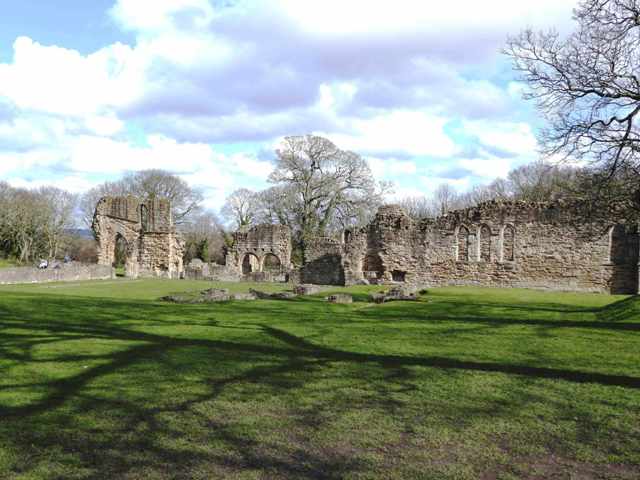
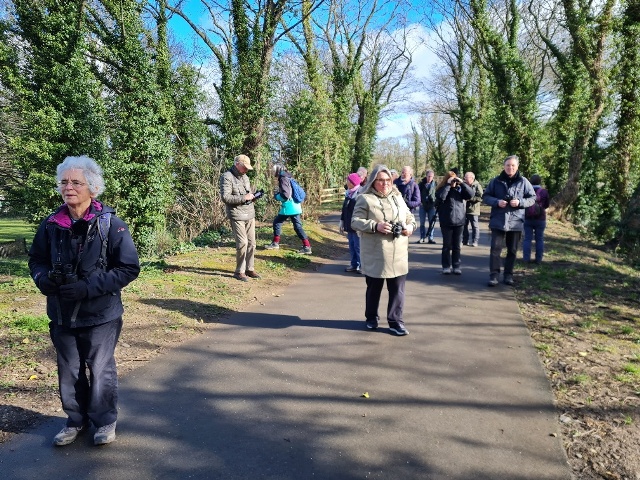
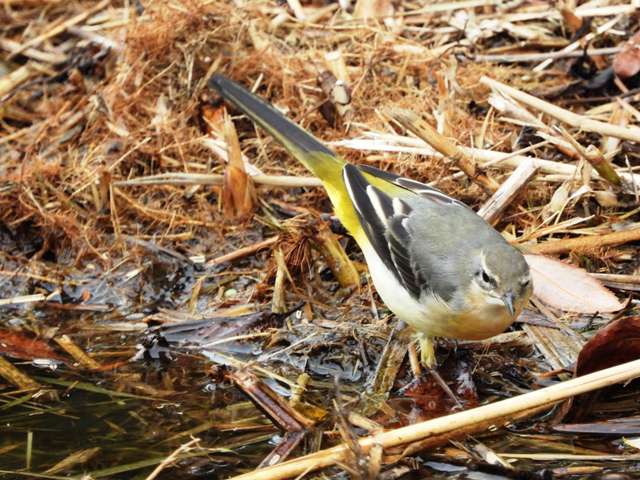
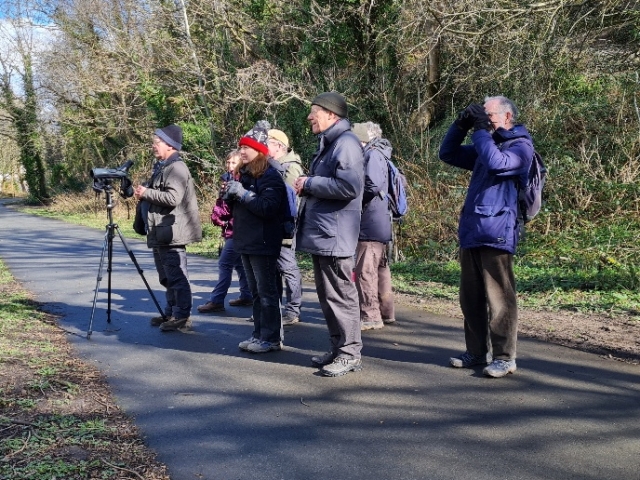
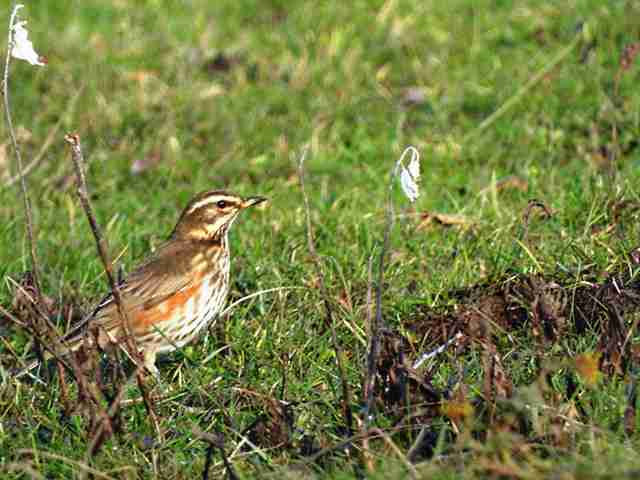
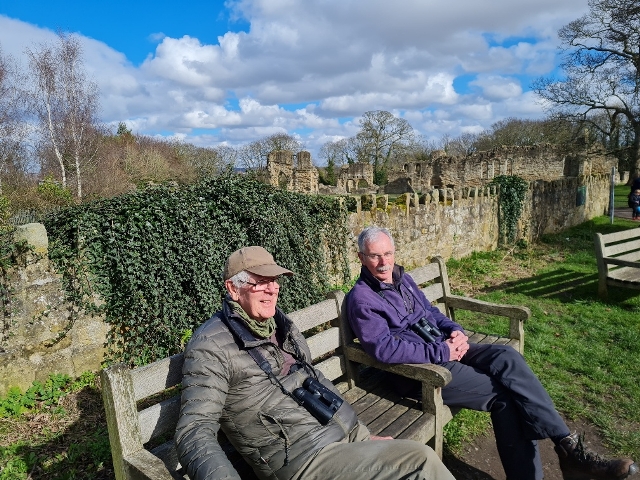
Marshside RSPB and Mere Sands Wood Nature Reserve – Saturday 12th February 2022
The birding got off to a good start with a Great Egret and a Peregrine seen from the car park as members were still arriving. A small group of Pink-footed Geese dropped in on the marsh. A baker’s dozen of us moved on to the screen over-looking the pools. Several duck species were present albeit a little distant, including Tufted, Shoveler, Teal, Pintail and Wigeon. The cold wind made it tricky to keep bins and scopes steady, so we moved on to the main hide.
Again, the birds were not as close as they often are, but there were several Gadwall and a male Pochard, and Colin picked out a sole Snipe.
Periodically clouds of Lapwing took to the air. Sometimes Golden Plover accompanied them. Then we realised why they were so nervous when we spotted a pair of peregrines hunting at the back of the reserve for several minutes, putting all the birds up as the hunters swooped up and down in earnest. What a display!
We decided to brave the wind again and walked down the road to scan the salt marsh. We took advantage of road work hardware to shelter behind! But the marsh was quiet and we returned to the cars. The last species here seen by Ellie was Reed Bunting including a lovely male bird.
We moved on to Mere Sands Wood. Here we had an early lunch and made use of the new café and visitors centre, before resuming our birding. Now we were much more sheltered and there are more hides to make use of (although 3 were unfortunately closed for repairs). We quickly started to add more species from scanning the main pool – Little Grebe, at least 4 smart Goosanders and Cormorant. Little Grebe and more of the usual duck species were also on the water, and a Mediterranean Gull was found amongst a small flock of Black-headed Gulls.
It was initially quiet walking through the woods but then we came across a hive of activity with Siskin, Goldfinch, Redwing, Fieldfare, Great-spotted Woodpecker, Treecreeper and Nuthatch all seen in quick succession, plus 4 tit species and numerous Robins. On farmland surrounding the reserve 3 Hares were noted. Sadly, we didn’t see a Kingfisher, but that is a good reason to come back again soon!
The group as a whole saw 56 species in total across the two sites, a very successful day. And the rain kept off which was a great bonus.
Thank you to everyone that turned out given the weather forecast. I hope you enjoyed the day.
Photos are curtesy of Ellie, Mike and Hugh.
Hugh Stewart
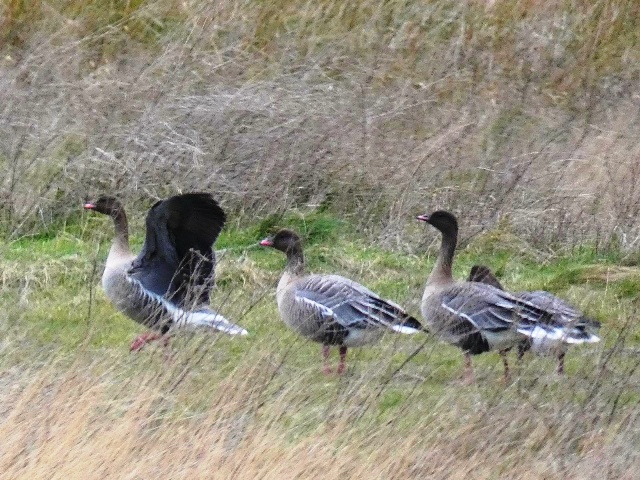
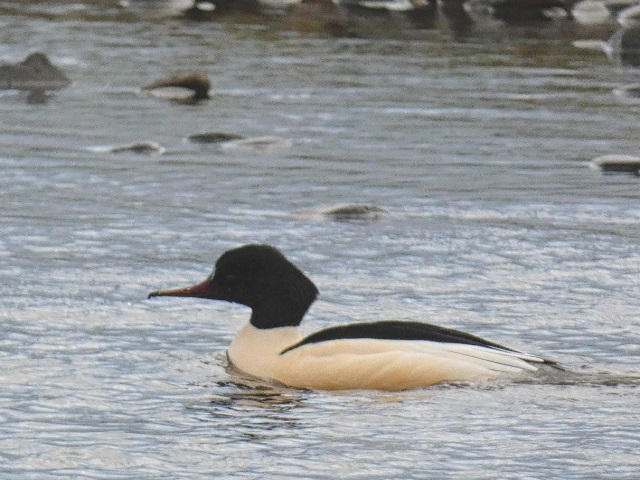
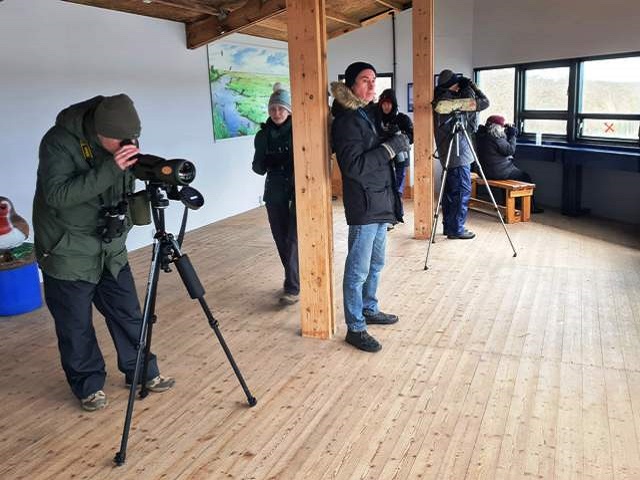
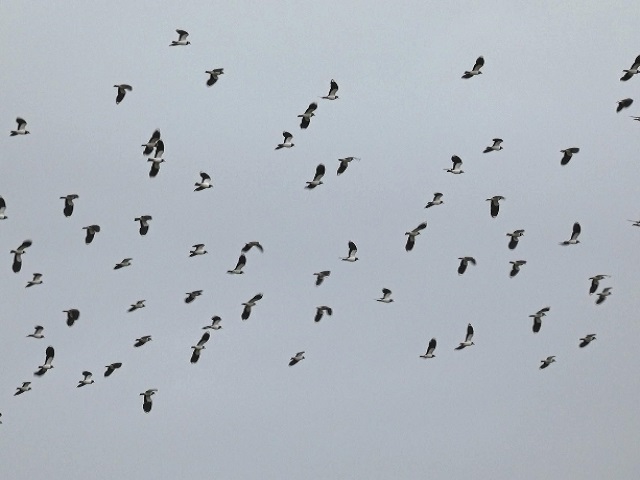
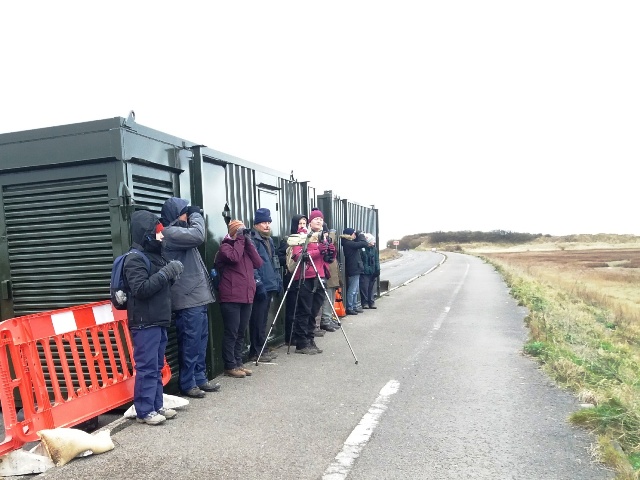
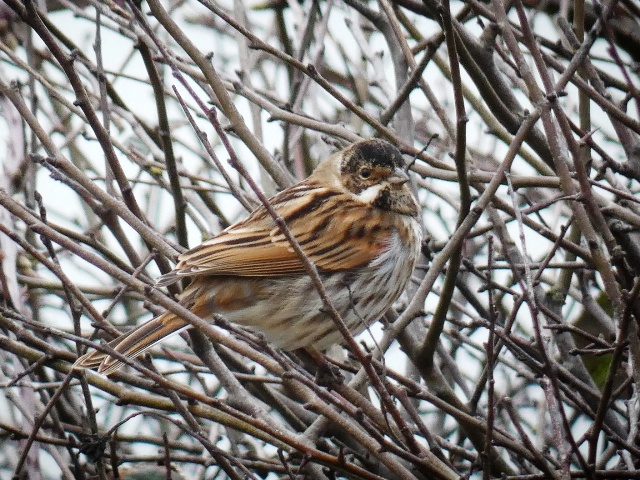
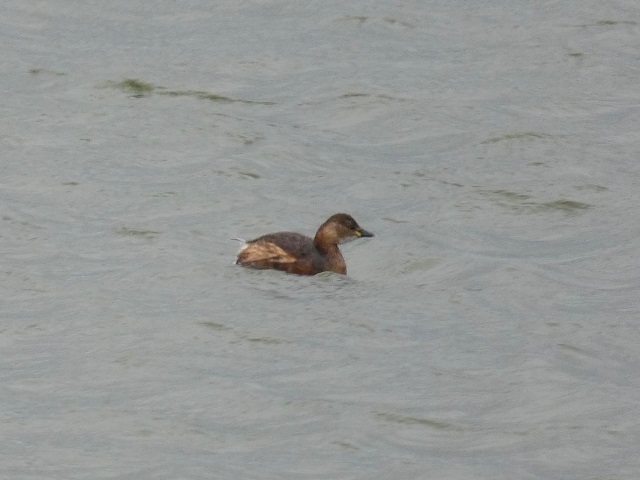
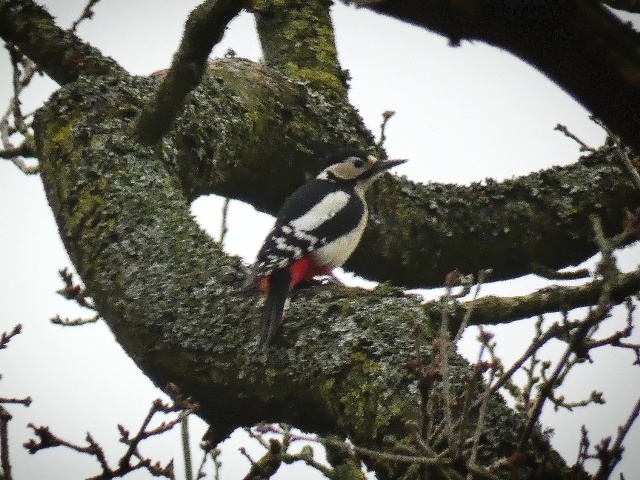
Burton Mere Wetlands RSPB – Thursday 6th January 2022
First of all, a big “Thank You” to the members that turned out on such a cold, wet day! We started off taking shelter in the Visitors Centre. The Mere was somewhat lacking in birds but Carolyn picked out a Water Rail working the margins just outside the window – a great spot. Also on Reception Pool were a Great Egret and a Little Egret allowing an educational comparison. Redshank, a few Black-tailed Godwits and a single Curlew were the only waders.
The rain eased a bit and we braved outside. Walking around the fishing lakes, the rain came on again and we moved quickly on to Marsh Covert Hide. We saw little from here other than distant birds on Bridge Pool. Eventually the rain let off again, and the clouds even lifted a little. Bridge Screen held Teal and Shoveler, and a brief Gadwall in flight. A Kestrel hovered nearby. At the new Border Hide, there were more duck and a Grey Heron, but it was still rather quiet bird-wise. A Buzzard did pass slowly over.
We started to retrace our steps. Initially the view from the Reedbed Screen looked empty, but then we saw some movement in the water. It turned out to be an Otter, which gave brilliant views as it dived and resurfaced close by. Without doubt this was both unexpected and mesmerising. We were so entranced that we forgot to take photos!
A bit further on, we were entertained by a pair of tame Robins that fed from our hands, thanks to some bird seed that Bill had secreted in his pocket!
Just before we got back to the warmth of the Centre, we saw a small flock of Siskin and Goldfinch feeding high in the trees.
Despite the awful weather, we saw 50 species between us. Not a bad start to the year.
Hugh Stewart
